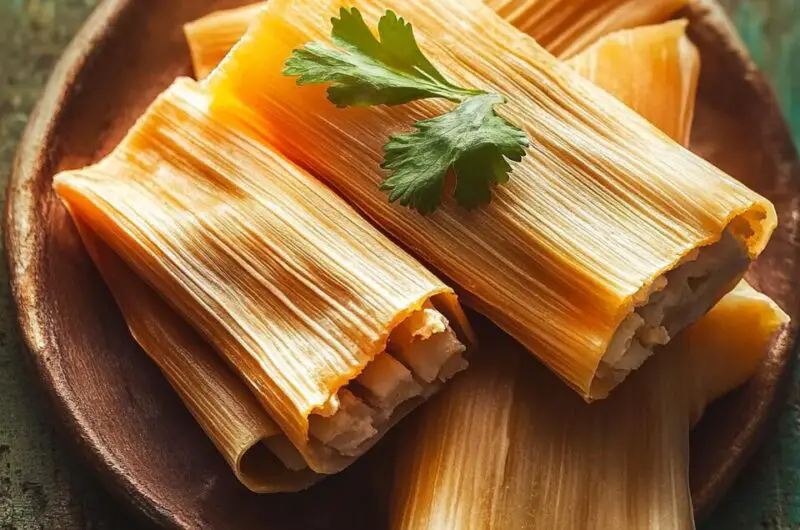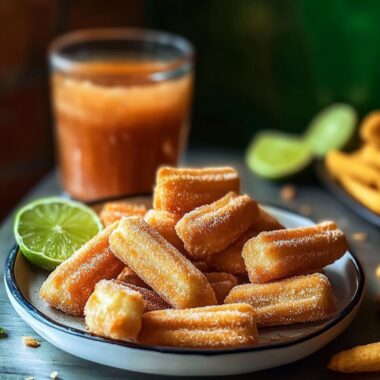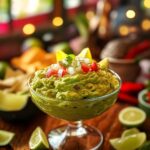The heart of any great Cinco de Mayo celebration lies in tradition—and nothing captures that better than Classic Tamales. These hand-wrapped treasures of masa dough and savory filling are a labor of love, passed down through generations and shared among friends and family.
Whether you’re preparing them for a party or simply to enjoy at home, these tamales bring together bold flavors, comforting textures, and the joy of cooking from scratch. Filled with juicy, seasoned chicken and wrapped in warm corn husks, every bite is a celebration of heritage and home-cooked goodness.
Full recipe:
Ingredients:
-
4 cups masa harina (corn flour)
-
2 ½ cups chicken broth (warm)
-
1 cup lard or vegetable shortening
-
1 ½ teaspoons baking powder
-
1 teaspoon salt
-
2 cups cooked, shredded chicken (or pork)
-
1 ½ cups red chile sauce or salsa verde (for meat)
-
30-35 dried corn husks, soaked in warm water for 30 minutes
-
Optional: sliced olives, jalapeños, cheese for filling variation
Directions:
-
In a large bowl, beat the lard or shortening until fluffy.
-
In a separate bowl, combine masa harina, baking powder, and salt. Gradually add warm broth to the masa until a soft dough forms.
-
Mix the masa into the whipped lard and beat until the dough is smooth and pliable. A good test is if a small piece of dough floats in water—it’s ready.
-
In a skillet, combine shredded chicken with the red chile sauce. Warm over medium heat until well combined.
-
Drain and pat dry the corn husks. Lay one husk flat and spread about 2 tablespoons of masa dough over the center, leaving space at the edges.
-
Add a spoonful of the meat filling in the center of the dough.
-
Fold the sides of the husk over the filling, then fold the bottom up to seal. Tie with kitchen string or a strip of husk if desired.
-
Repeat with remaining dough and filling.
-
Arrange the tamales standing up in a large steamer pot. Steam for 60–75 minutes, or until the masa pulls away easily from the husk.
-
Let cool slightly before serving. Enjoy with salsa, crema, or guacamole.
Prep Time: 45 minutes | Cooking Time: 75 minutes | Total Time: 2 hours
Kcal: 310 kcal | Servings: 20 tamales
The Cultural Roots of Tamales
Tamales are a quintessential dish in Mexican cuisine with deep historical roots stretching back thousands of years to Mesoamerican civilizations. The word tamalli comes from the Nahuatl language, spoken by the Aztecs, and literally means “wrapped food.” Tamales were traditionally prepared for feasts, religious ceremonies, and communal gatherings. Over time, they evolved in ingredients and preparation techniques, influenced by regional and family traditions.
For Cinco de Mayo, tamales represent more than just a dish—they embody cultural pride, resistance, and celebration. Making tamales is often a family affair, with multiple generations gathering in the kitchen, each person assigned to a part of the process. This act of togetherness mirrors the unity and cultural resilience celebrated on Cinco de Mayo itself.
Why Classic Tamales Are a Must-Have for Cinco de Mayo
When people think of Cinco de Mayo, their minds often go to festive colors, mariachi music, and, of course, delicious food. Tamales fit perfectly into this celebration for several reasons. First, they are portable and easy to serve at parties or potlucks. Second, their customizable filling options make them suitable for all kinds of palates—from meat lovers to vegetarians and even vegans.
Tamales bring authenticity to the celebration. Unlike store-bought snacks or fusion dishes, homemade tamales offer a taste of tradition that can’t be replicated. They’re a homage to the spirit of the holiday, honoring Mexico’s heritage while creating new memories around the table.
Health and Nutritional Benefits of Tamales
While tamales are often viewed as indulgent, they offer several nutritional benefits when made with wholesome ingredients. Masa, made from corn, is naturally gluten-free and provides fiber and essential minerals like magnesium and phosphorus. By using lean meats like chicken or opting for vegetable-based fillings, tamales can be a well-rounded, nutritious option.
Switching out lard for vegetable shortening or using olive oil reduces saturated fat content. Additionally, incorporating fillings like black beans, zucchini, or spinach can increase the fiber and vitamin levels in each tamale. Because they’re steamed rather than fried, tamales also retain more nutrients and have lower fat content compared to other festive foods.
What Makes This Tamale Recipe Special
This classic tamale recipe is beloved because it balances tradition with accessibility. The masa dough is light and tender, thanks to the fluffing technique used with lard or shortening, and the meat filling is rich in flavor without being overwhelming. The recipe is beginner-friendly yet yields results worthy of a seasoned cook.
Another key to its excellence is its adaptability. You can easily substitute pork for chicken or even add a spicy vegetarian mix of roasted peppers and cheese. The included red chile sauce adds depth and authenticity, infusing each tamale with bold, smoky flavor. The technique of testing the masa dough to see if it floats—a time-honored tradition—ensures perfect texture every time.
Tips for First-Time Tamale Makers
Making tamales can feel intimidating, but with a few helpful tips, anyone can master the process. First, be sure to soak your corn husks in warm water for at least 30 minutes to make them pliable. When spreading the masa, use a spoon or spatula dipped in water to prevent sticking.
Organize a tamalada (tamale-making party) to share the workload and make the process more fun. Assign roles: someone to soak husks, another to spread masa, and others to fill and fold. Not only will this speed up production, but it will also bring a communal, joyful spirit to the kitchen.
Lastly, don’t overcrowd your steamer. Stand the tamales upright with the open ends facing up, and steam with a tight-fitting lid. Add water as needed throughout the process to keep the steam going strong.
How to Customize Your Tamales for Every Diet
One of the best features of this tamale recipe is how customizable it is. For vegetarians, try a filling of sautéed mushrooms, onions, and poblano peppers with a sprinkle of cheese. For a vegan twist, use mashed black beans with chipotle peppers and olive oil in the masa instead of lard.
If you’re looking to add a gourmet flair, experiment with fillings like mole chicken, cochinita pibil (slow-roasted pork), or even dessert versions with sweet masa and cinnamon-infused fruits. The versatility of tamales makes them ideal for catering to diverse dietary needs and flavor profiles.
How to Store and Reheat Tamales
Tamales are great for meal prep and make-ahead dinners. To store, let them cool completely and then wrap them individually in parchment paper or plastic wrap. Place them in an airtight container in the fridge for up to a week, or freeze for up to three months.
Reheating is simple. For best results, steam them again for 10-15 minutes or wrap them in a damp paper towel and microwave them in 1-minute intervals until hot. They retain their moisture well and are just as delicious the next day—sometimes even better!
Pairing Suggestions for a Full Cinco de Mayo Spread
To complete your Cinco de Mayo feast, serve these tamales with fresh sides like Mexican street corn (elote), guacamole, or a light jicama salad. Add a tangy tomatillo salsa or creamy avocado crema on the side for dipping. A pitcher of hibiscus tea (agua de jamaica) or a sparkling lime margarita makes the perfect pairing for this savory main dish.
For dessert, keep it festive with traditional Mexican sweets like flan, tres leches cake, or cinnamon sugar churros. Whether it’s a small family dinner or a big party, tamales make the perfect centerpiece for any Cinco de Mayo menu.
A Recipe That Brings People Together
More than just a food, tamales symbolize connection—between generations, between friends, and between cultures. They’re often made in batches of dozens or even hundreds, shared across communities and family networks. For many, the act of making tamales is just as meaningful as eating them.
This recipe carries that tradition forward, allowing anyone—no matter their skill level—to be part of something larger. Whether you’re reconnecting with your roots or exploring a new cultural dish, tamales offer a delicious and deeply meaningful experience.
Conclusion
Classic Tamales are more than a delicious meal—they’re a celebration of heritage, community, and flavor. Whether you’re a seasoned cook or a curious beginner, this recipe offers a gateway into one of the most iconic and beloved traditions in Mexican cooking.
With every bite, you get more than taste—you get a story, a legacy, and a reason to gather. So this Cinco de Mayo, bring tamales to the table and let the celebration begin.







